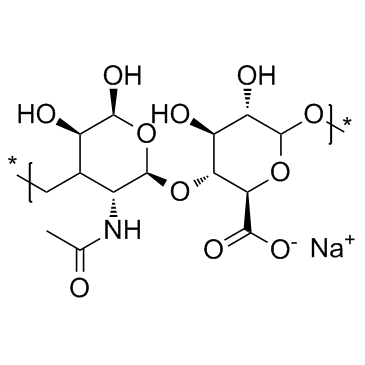
Sodium Hyaluronate
CAS No. 9067-32-7
Sodium Hyaluronate( Hyaluronic acid sodium salt )
Catalog No. M19838 CAS No. 9067-32-7
Hyaluronic acid (HA) is an anionic nonsulfated glycosaminoglycan distributed widely throughout connective epithelial and neural tissues. It is unique among glycosaminoglycans in that it is nonsulfated forms in the plasma membrane instead of the Golgi and can be very large with its molecular weight often reaching the millions.
Purity : >98% (HPLC)
 COA
COA
 Datasheet
Datasheet
 HNMR
HNMR
 HPLC
HPLC
 MSDS
MSDS
 Handing Instructions
Handing Instructions
| Size | Price / USD | Stock | Quantity |
| 50MG | 48 | In Stock |


|
| 100MG | 65 | In Stock |


|
| 200MG | 80 | In Stock |


|
| 500MG | 135 | In Stock |


|
| 1G | 170 | In Stock |


|
Biological Information
-
Product NameSodium Hyaluronate
-
NoteResearch use only, not for human use.
-
Brief DescriptionHyaluronic acid (HA) is an anionic nonsulfated glycosaminoglycan distributed widely throughout connective epithelial and neural tissues. It is unique among glycosaminoglycans in that it is nonsulfated forms in the plasma membrane instead of the Golgi and can be very large with its molecular weight often reaching the millions.
-
DescriptionHyaluronic acid (HA) is an anionic nonsulfated glycosaminoglycan distributed widely throughout connective epithelial and neural tissues. It is unique among glycosaminoglycans in that it is nonsulfated forms in the plasma membrane instead of the Golgi and can be very large with its molecular weight often reaching the millions. One of the chief components of the extracellular matrix hyaluronic acid contributes significantly to cell proliferation and migration and may also be involved in the progression of some malignant tumors.(In Vitro):Hyaluronic acid (HA) is widely used in aesthetic medicine due to its binding ability with a large number of water molecules. It improves tissue hydration and their resistance to mechanical damage. HA plays an important role in wound healing, ovulation, fertilization, signal transduction, and tumor physiology. HA is used in joint diseases such as osteoarthritis or rheumatoid arthritis. HA of a high molecular mass reduces the chemotaxis and migration of inflammatory cells which acts as a good barrier to the inflammatory process and protects against the effects of free radicals. HA is used in ophthalmology due to its lubricating properties for the corneal endothelium, and improves tissue hydration and cellular resistance to mechanical damage in aesthetic dermatology, and has marginal adverse effects. Several trials indicate its role in tumor markers, liver diseases, and in pharmaceuticals. Hyaluronan plays an important role in cancer growth and metastasis. HA and HA fragment-tumor cell interaction could activate the downstream signaling pathways, promoting cell proliferation, adhesion, migration and invasion, and inducing angiogenesis, lymphangiogenesis, epithelial-mesenchymal transition, stem cell-like property, and chemoradioresistance in digestive cancers.(In Vivo):The impact of applied intra-articular HA has been proven in many studies in animals. Studies on HA have shown that it promotes the synthesis of cartilage matrix, prevents its degradation, reduces inflammation, stimulates the synthesis of endogenous HA, and improves the resilience and moisture of cartilage. High molecular size HA preparations, applied topically, promote healing of fresh skin wounds. They also promote the healing of venous leg ulcers and are useful in the management of chronic wounds.
-
In VitroHyaluronic acid (HA) is widely used in aesthetic medicine due to its binding ability with a large number of water molecules. It improves tissue hydration and their resistance to mechanical damage. HA plays an important role in wound healing, ovulation, fertilization, signal transduction, and tumor physiology. HA is used in joint diseases such as osteoarthritis or rheumatoid arthritis. HA of a high molecular mass reduces the chemotaxis and migration of inflammatory cells which acts as a good barrier to the inflammatory process and protects against the effects of free radicals. HA is used in ophthalmology due to its lubricating properties for the corneal endothelium, and improves tissue hydration and cellular resistance to mechanical damage in aesthetic dermatology, and has marginal adverse effects. Several trials indicate its role in tumor markers, liver diseases, and in pharmaceuticals. Hyaluronan plays an important role in cancer growth and metastasis.HA and HA fragment-tumor cell interaction could activate the downstream signaling pathways, promoting cell proliferation, adhesion, migration and invasion, and inducing angiogenesis, lymphangiogenesis, epithelial-mesenchymal transition, stem cell-like property, and chemoradioresistance in digestive cancers.
-
In VivoThe impact of applied intra-articular HA has been proven in many studies in animals. Studies on HA have shown that it promotes the synthesis of cartilage matrix, prevents its degradation, reduces inflammation, stimulates the synthesis of endogenous HA, and improves the resilience and moisture of cartilage. High molecular size HA preparations, applied topically, promote healing of fresh skin wounds. They also promote the healing of venous leg ulcers and are useful in the management of chronic wounds.
-
SynonymsHyaluronic acid sodium salt
-
PathwayOthers
-
TargetOther Targets
-
RecptorOthers
-
Research AreaOthers
-
IndicationFrozen shoulder
Chemical Information
-
CAS Number9067-32-7
-
Formula Weight403.31
-
Molecular FormulaC14H22NNaO11
-
Purity>98% (HPLC)
-
SolubilityDMSO:10 mM
-
SMILES——
-
Chemical Name——
Shipping & Storage Information
-
Storage(-20℃)
-
ShippingWith Ice Pack
-
Stability≥ 2 years
Reference



-
ELA-32 (human)
Potent, high affinity apelin receptor agonist (IC50 = 0.27 nM; Kd = 0.51 nM). Exhibits no binding GPR15 and GPR25. Activates the PI3K/AKT pathway and promotes self-renewal of hESCs via cell-cycle progression and protein translation. Also potentiates the TGFβ pathway, priming hESCs toward the endoderm lineage. Stimulates angiogenesis in HUVEC cells. Relaxes mouse aortic vessels. Functions as an anorexigenic hormone through activation of the AVP and CRH neurons in the PVN.
-
Hydroxytuberosone
Hydroxytuberosone is a natural product from Pueraria lobata.
-
Remimazolam Tosilate...
Remimazolam Tosilate is a benzodiazepine derivative drug as an alternative to the short-acting imidazobenzodiazepine midazolam.



 Cart
Cart
 sales@molnova.com
sales@molnova.com


